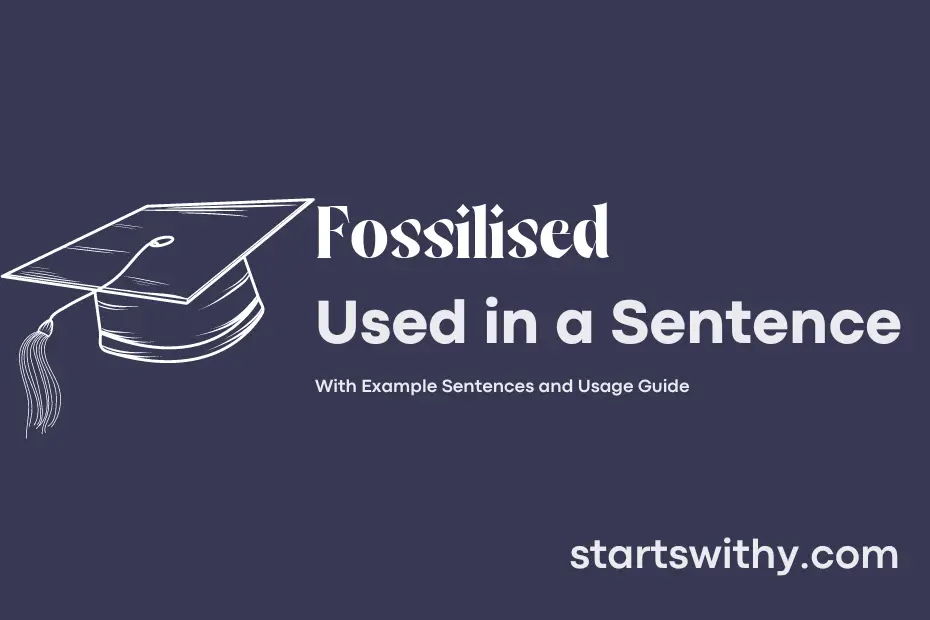Have you ever wondered how fossils provide us with a window into the distant past? Fossilisation is the remarkable process by which organic materials transform into rock-like structures over millions of years. In simple terms, fossilisation occurs when the remains of plants or animals become encased in sediment or minerals, preserving them as fossils.
Fossilised remains hold vital clues for scientists studying ancient life forms, allowing them to reconstruct the history of our planet and the organisms that once inhabited it. By analyzing these well-preserved specimens, researchers can gain valuable insights into evolution, environmental conditions, and the diversity of life that existed long before humans walked the Earth.
7 Examples Of Fossilised Used In a Sentence For Kids
- Fossilised dinosaur bones are very old.
- We can find fossilised shells in the ground.
- Fossilised plants can teach us about the past.
- A fossilised bug in amber is very special.
- We should handle fossilised rocks carefully.
- Fossilised footprints show where dinosaurs walked.
- Some fossilised animals lived in the sea.
14 Sentences with Fossilised Examples
- Fossilised remains of ancient organisms can be found in sedimentary rocks.
- The fossilised footprints of early humans provide valuable insights into their movement and behavior.
- Scholars study fossilised pollen grains to understand ancient plant species and ecosystems.
- The museum exhibition featured a collection of fossilised dinosaur bones.
- Researchers use fossilised DNA to trace evolutionary relationships between species.
- Paleontology students eagerly dig for fossilised shells and marine life in coastal regions.
- The discovery of a fossilised tree stump excited geology enthusiasts.
- The expedition team unearthed a fossilised plant specimen dating back millions of years.
- The student’s thesis focused on the analysis of fossilised insects preserved in amber.
- A rare fossilised fish skeleton was displayed at the campus paleontology exhibit.
- The professor’s lecture on fossilised remains shed light on prehistoric animal behavior.
- The geology field trip included a visit to a fossilised swamp from the Mesozoic era.
- Excavating fossilised bones requires precise tools and techniques to avoid damage.
- The laboratory analysis confirmed the authenticity of the fossilised plant sample.
How To Use Fossilised in Sentences?
To use the word Fossilised correctly in a sentence, follow these steps:
-
Understand the meaning of Fossilised: The word Fossilised means to convert into a fossil or to become antiquated or rigid in one’s ideas, methods, or practices.
-
Choose the appropriate context: Fossilised can refer to both literal fossilisation of remains or metaphorical fossilisation of ideas or practices. Decide which meaning you want to convey in your sentence.
-
Construct your sentence: For literal usage, you could say, “The dinosaur bones were fossilised over millions of years.” For metaphorical usage, you could say, “The company’s policy was so outdated, it had become fossilised and resistant to change.”
-
Check the sentence for accuracy: Ensure that the sentence accurately reflects the intended meaning of Fossilised and that the context is clear to the reader.
-
Practice using Fossilised in different sentences to become more familiar with its meaning and usage. This will help you feel more confident incorporating it into your writing.
By following these steps, you can effectively incorporate the word Fossilised into your vocabulary and communicate more clearly in your writing.
Conclusion
In conclusion, fossilised sentences, like those provided earlier, are prime examples of language that has been preserved in a fixed form. These sentences serve as a window into the past, offering insights into the historical development of language usage and grammar. By studying fossilised sentences, linguists can trace the evolution of language patterns and understand how certain expressions or structures have endured over time.
Through analysing fossilised sentences, researchers can uncover valuable information about language change and continuity. These preserved linguistic artifacts not only shed light on past language practices but also help us appreciate the rich diversity and complexity of human communication. Studying fossilised sentences is therefore crucial for gaining a deeper understanding of language evolution and the enduring legacy of linguistic expressions.



